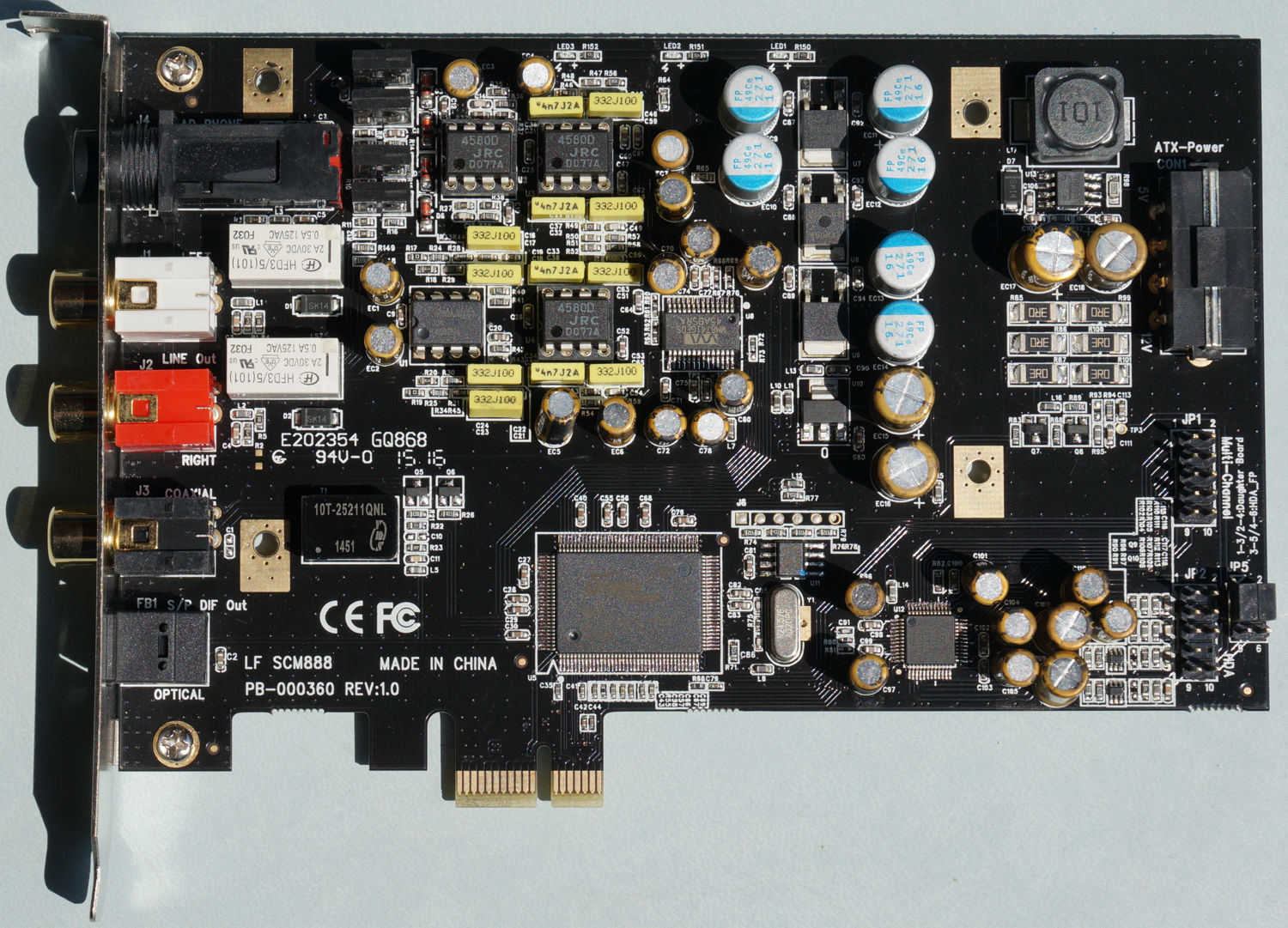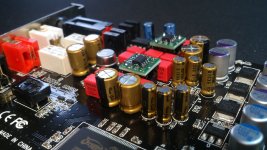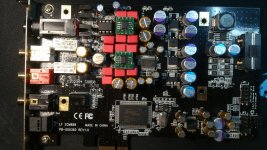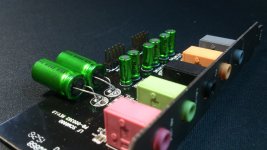The 4580 is already a fairly reasonable 'high grade device' 
Texas Instruments - datasheet pdf
You also need to be aware that although in most cases opamps can be swapped at will, its not guaranteed, and problems can arise.
http://www.diyaudio.com/forums/anal...u-have-checked-see-its-stable-havent-you.html
Texas Instruments - datasheet pdf
You also need to be aware that although in most cases opamps can be swapped at will, its not guaranteed, and problems can arise.
http://www.diyaudio.com/forums/anal...u-have-checked-see-its-stable-havent-you.html
Hi Mooly!
Nice to hear the used opamps are good
The card is advertised with the ability to change the opamps so I'm sure I will find a few which I could try to use.
I've read your thread and how I understood is that some changes in sound are caused by instability rather then the opamps sound itself right?
But it doesnt mean that its not possible to find a opamp/instability sound which I maybe like better than the original opamps or? (lol)
Are there any other problems that could arise besides the alteration of the intended opamps sound due to instability?
The soundcard uses the Wolfson WM8741 DAC
here is a picture of the soundcard

Nice to hear the used opamps are good
The card is advertised with the ability to change the opamps so I'm sure I will find a few which I could try to use.
I've read your thread and how I understood is that some changes in sound are caused by instability rather then the opamps sound itself right?
But it doesnt mean that its not possible to find a opamp/instability sound which I maybe like better than the original opamps or? (lol)
Are there any other problems that could arise besides the alteration of the intended opamps sound due to instability?
The soundcard uses the Wolfson WM8741 DAC
here is a picture of the soundcard

Besides instability you need to check that the chosen opamps can work with the supply voltages used on the card. 99.9% chance there isn't an issue here although the 4580 is one of the few that can work at very low voltages (-/+2 volts). It can also drive low impedance loads well (it has a relatively high output current capability of -/+50ma) and so if its used as headphone amplifier this is important.
If you just want to experiment to see if you can discern audible differences then try the NJM4558 or JRC4558 and the TL072 or TL082. These cost peanuts and it would be an informative exercise fitting them. You might like them. Keep an open mind and listen. The other two to try are the LM4562 and the OPA2604.
Always buy semiconductors from accredited recognised suppliers such as Farnell, Mouser, RS, Digikey etc. Other sources are flooded with fakes and seconds.
If you just want to experiment to see if you can discern audible differences then try the NJM4558 or JRC4558 and the TL072 or TL082. These cost peanuts and it would be an informative exercise fitting them. You might like them. Keep an open mind and listen. The other two to try are the LM4562 and the OPA2604.
Always buy semiconductors from accredited recognised suppliers such as Farnell, Mouser, RS, Digikey etc. Other sources are flooded with fakes and seconds.
Thanks a lot!
I'm able to order at mouser and digikey (and reichelt, a credible vendor) from where I live.
The opamp which drives the headphone output is not used at the moment. I dont have any decent headphones around right now.
I heard read good things about the Burr Brown OPA opamps on these forums I think I will give them a shot, the both last you wrote. Are there any other BurrBrown models which could be interesting?
Like you already realised I just want to experiment a little bit.
Maybe I will change the caps used to some Nichicon Muse too. I really want to mod this piece a little bit.
Thanks Mooly!
I'm able to order at mouser and digikey (and reichelt, a credible vendor) from where I live.
The opamp which drives the headphone output is not used at the moment. I dont have any decent headphones around right now.
I heard read good things about the Burr Brown OPA opamps on these forums I think I will give them a shot, the both last you wrote. Are there any other BurrBrown models which could be interesting?
Like you already realised I just want to experiment a little bit.
Maybe I will change the caps used to some Nichicon Muse too. I really want to mod this piece a little bit.
Thanks Mooly!
Based on the components on the board, the 1/4" jack have emitter follower boosted outputs, so the loading on the opamp might not be so big.
I can't tell what the regulators are so uncertain what the voltage might be. You can measure it directly from the legs of the opamps though.
It would appear a LM4562 is already fitted on the line output stage.
Aside from the already suggested, one that I might try on what presumably is the I/V stages after the DAC would be the ADA4075.
I can't tell what the regulators are so uncertain what the voltage might be. You can measure it directly from the legs of the opamps though.
It would appear a LM4562 is already fitted on the line output stage.
Aside from the already suggested, one that I might try on what presumably is the I/V stages after the DAC would be the ADA4075.
Yo its me again 
I will replace nearly ALL caps on this card.
There are 4 caps I want to replace with polymer caps and I am not able to get my hands on Oscons with 220uF/25V since they are not at stock everywhere. Also the Chemicon PSG 220uF/25V isnt available.
Is it safe to replace a 220uF/25V with a 330uF/25V ?
you can see where the caps are located on that picture.
I know never go lower on caps, higher voltage is okay too, but what about capacitance?
Otherwise i have to decide to take a Wurth Polymer Capacitor 220uF/25V or Muse KZ.
I'm not sure about Wurth because there is absolutely no reviews on caps of them, and some guys out there think they may be rebranded caps.
I'm still pretty unsure about the OpAmps, I will order the suggested OPA2604 and ADA4075 for sure and a few more to play with. (ex.AD8599)
Yes there is already a LM4562 fitted on the card. Its soldered on it.
I will desolder that one and place a DIP Socket there just to make things easier in future.
Is a OPA627 really worth its price? I think about placing 2x OPA627 (soldered on dual browndog) to the lineout where the LM4562 sits now.
I will replace nearly ALL caps on this card.
There are 4 caps I want to replace with polymer caps and I am not able to get my hands on Oscons with 220uF/25V since they are not at stock everywhere. Also the Chemicon PSG 220uF/25V isnt available.
Is it safe to replace a 220uF/25V with a 330uF/25V ?
you can see where the caps are located on that picture.
I know never go lower on caps, higher voltage is okay too, but what about capacitance?
Otherwise i have to decide to take a Wurth Polymer Capacitor 220uF/25V or Muse KZ.
I'm not sure about Wurth because there is absolutely no reviews on caps of them, and some guys out there think they may be rebranded caps.
I'm still pretty unsure about the OpAmps, I will order the suggested OPA2604 and ADA4075 for sure and a few more to play with. (ex.AD8599)
Yes there is already a LM4562 fitted on the card. Its soldered on it.
I will desolder that one and place a DIP Socket there just to make things easier in future.
Is a OPA627 really worth its price? I think about placing 2x OPA627 (soldered on dual browndog) to the lineout where the LM4562 sits now.
An externally hosted image should be here but it was not working when we last tested it.
330uf is OK to use a replacement for 220uf but just going bigger for the sake of it isn't always advisable.
The OPA627 is a very high performance device and yes, its worth the money if you need the performance it offers and can capitalise on that performance. Using it as a drop in replacement and hoping its better in some way probably won't work... and it may not take kindly to browndog adapters as the device is wide bandwidth and thus needs suitable care and precautions in layout to avoid instability.
The OPA627 is a very high performance device and yes, its worth the money if you need the performance it offers and can capitalise on that performance. Using it as a drop in replacement and hoping its better in some way probably won't work... and it may not take kindly to browndog adapters as the device is wide bandwidth and thus needs suitable care and precautions in layout to avoid instability.
thx finally i'm able to place that order (searched about a week for suitable caps)
Its not like i need that performance, but I love enjoying good sound.
I will look once more on that thread you posted before to learn how to care and doing precautions to avoid instability (i have no clue to check for suitable opamps besided checking the datasheets and measure with that scope)
greetz RFiD (DIY noob ^^)
Its not like i need that performance, but I love enjoying good sound.
I will look once more on that thread you posted before to learn how to care and doing precautions to avoid instability (i have no clue to check for suitable opamps besided checking the datasheets and measure with that scope)
greetz RFiD (DIY noob ^^)
Hey guys, Hey Mooly!
this is a great forum! i learned so much the last few weeks reading threads here.
I bought a semi professional smd soldering station with iron and hot air blower and have done my very first electronic soldering. You got me, i think im f**kin into it
I reworked the whole card lol.
On the main card I have used Nichicon "Finegold", Nichicon KA, OSCONs and Chemicon APSG. The film capacitors have been replaced with WIMA FKP2(with tighter tolerances)
Also placed an additional DIP socket where the LM4562 was soldered into the pcb.
The opamps replaced: changed the LM4562 to LME49720HA - replaced the 4580D with AD8599.
the sound dramatically improved after changing the caps (tested with the original opamps at first)
On the daughter card: Nichicon MUSE Bipolar
Great forum. I love it! I'll get my next mouser order delivered tomorrow.
goin to replace every cap and Resistor in my Speakers also replace 2 12000uF cap in my Denon avr (and when replacing them i will check the numbers of all other caps and resistors, but only for the important channels that I need)
also replace 2 12000uF cap in my Denon avr (and when replacing them i will check the numbers of all other caps and resistors, but only for the important channels that I need)
Peace!!
this is a great forum! i learned so much the last few weeks reading threads here.
I bought a semi professional smd soldering station with iron and hot air blower and have done my very first electronic soldering. You got me, i think im f**kin into it
I reworked the whole card lol.
On the main card I have used Nichicon "Finegold", Nichicon KA, OSCONs and Chemicon APSG. The film capacitors have been replaced with WIMA FKP2(with tighter tolerances)
Also placed an additional DIP socket where the LM4562 was soldered into the pcb.
The opamps replaced: changed the LM4562 to LME49720HA - replaced the 4580D with AD8599.
the sound dramatically improved after changing the caps (tested with the original opamps at first)
On the daughter card: Nichicon MUSE Bipolar
Great forum. I love it! I'll get my next mouser order delivered tomorrow.
goin to replace every cap and Resistor in my Speakers
Peace!!
Attachments
I've read a few times that (metalized and non)polyester film caps are the least caps to choose when looking for film capacitor but is a metalized Polyester film cap still better than a bipolar electrolytic cap?
When looking for 8.2uF/100V Bipolar caps i had no big choice. I ordered Nichicon UEP 10uF/100V and Panasonic ECQ-E 8.2uF/100V to be sure till I find out what to use.
When looking for 8.2uF/100V Bipolar caps i had no big choice. I ordered Nichicon UEP 10uF/100V and Panasonic ECQ-E 8.2uF/100V to be sure till I find out what to use.
Welcome to the hobby.
I don't find much profit in replacing electrolytic caps that aren't dried up. Your board was built after LM4562 was invented so that is pretty recent.
Different film caps do have a sound, but the differences are subtle.
Input cap, I really didn't like the tantalum ones I bought that had a frying pan noise. Electrolytic non-polar sound okay, but there are no 10000 hour service life ones (long life sealant) I have seen stocked. Film 10 uf are huge and sometimes won't fit. I keep my equipment 40 years or more so I like long life caps better than replacing them 2 or 3 times as I have had to do on my dynakit equipment.
High value (>100k) carbon resistors hiss worse IMHO than metal film.
I find the JRC4580 to be okay sounding. It is used in Peavey mixers for high drive current for long cables.
I found the recommended 4558 in post 4 to be hissy in 50x gain mag phono circuits. I replaced mine in a disco mixer with ST33078, much better. but they oscillated until ceramic cap installation. JRC4580 is fast enough, your board should have ceramic bypass capacitors on the power rails near each fast op amp, and a ceramic bypass on the feedback resistor. I think I see some tiny SMD chips there, do confirm that those are installed for no oscillation. Lacking those, 4580 and fast BB parts (>8 v/micros) can oscillate pretty easily.
TI LM4562 is still on my upgrade to list, they were $3 apiece when I bought a quad. Now they are end of life; buy now if you ever want any. 72 db s/n is adequate for my listening purposes, I don't need 90+ db for mastering or anything like that. Hence no $6 BB parts yet.
I don't find much profit in replacing electrolytic caps that aren't dried up. Your board was built after LM4562 was invented so that is pretty recent.
Different film caps do have a sound, but the differences are subtle.
Input cap, I really didn't like the tantalum ones I bought that had a frying pan noise. Electrolytic non-polar sound okay, but there are no 10000 hour service life ones (long life sealant) I have seen stocked. Film 10 uf are huge and sometimes won't fit. I keep my equipment 40 years or more so I like long life caps better than replacing them 2 or 3 times as I have had to do on my dynakit equipment.
High value (>100k) carbon resistors hiss worse IMHO than metal film.
I find the JRC4580 to be okay sounding. It is used in Peavey mixers for high drive current for long cables.
I found the recommended 4558 in post 4 to be hissy in 50x gain mag phono circuits. I replaced mine in a disco mixer with ST33078, much better. but they oscillated until ceramic cap installation. JRC4580 is fast enough, your board should have ceramic bypass capacitors on the power rails near each fast op amp, and a ceramic bypass on the feedback resistor. I think I see some tiny SMD chips there, do confirm that those are installed for no oscillation. Lacking those, 4580 and fast BB parts (>8 v/micros) can oscillate pretty easily.
TI LM4562 is still on my upgrade to list, they were $3 apiece when I bought a quad. Now they are end of life; buy now if you ever want any. 72 db s/n is adequate for my listening purposes, I don't need 90+ db for mastering or anything like that. Hence no $6 BB parts yet.
Last edited:
Hello,
But transconductance aops, what, please,would be your choice for an DAC I/V job with a dac outputt of +/- 1mA / 2 to 3 k ohms / 250 ns settling time ?
bipolar oaps come to mind or very modern CMOS. current feedback oaps ? stable at unity-gain ? large bandwidth and fast slew rate ?
I like both the JRC4580DD & the LM4562 in preamp circuit but not sure it is adapted to this task...
Which is puzzling me is a dac works best at zero ohms, but how to drop those 2 to 3 k ohms to the max in relation to the oap to keep the dac chip perf at it best (linearity I assume?) ? Current mirror circuit between thee dac current outputt and the operational amlifier ?
Btw for the preamp of the topic convesation what would you choose to swap a 4580DD confortable with the same <= 2V inputt ?
forget/forgive me if I mix up the basics here...not sure I'm acurate enough to understand my needs here ! Not sure with the modern Cmos, biplars are still the best choice for that task ? comes in mind for bipolars opa1892 iirc or opa1602... cmos : 1652 or 2228 ?
Of course there are expensive ad797, opa827 but I would like to stay in more civilisated prices. I need single channel for the I/V purpose but double channel to swap the 4580DD in a preamp circuit after two 5k ohms pots (that are after rca input) : so assume low voltages< or = to 2 V inputt.
Many thanks if any links or advices related.
But transconductance aops, what, please,would be your choice for an DAC I/V job with a dac outputt of +/- 1mA / 2 to 3 k ohms / 250 ns settling time ?
bipolar oaps come to mind or very modern CMOS. current feedback oaps ? stable at unity-gain ? large bandwidth and fast slew rate ?
I like both the JRC4580DD & the LM4562 in preamp circuit but not sure it is adapted to this task...
Which is puzzling me is a dac works best at zero ohms, but how to drop those 2 to 3 k ohms to the max in relation to the oap to keep the dac chip perf at it best (linearity I assume?) ? Current mirror circuit between thee dac current outputt and the operational amlifier ?
Btw for the preamp of the topic convesation what would you choose to swap a 4580DD confortable with the same <= 2V inputt ?
forget/forgive me if I mix up the basics here...not sure I'm acurate enough to understand my needs here ! Not sure with the modern Cmos, biplars are still the best choice for that task ? comes in mind for bipolars opa1892 iirc or opa1602... cmos : 1652 or 2228 ?
Of course there are expensive ad797, opa827 but I would like to stay in more civilisated prices. I need single channel for the I/V purpose but double channel to swap the 4580DD in a preamp circuit after two 5k ohms pots (that are after rca input) : so assume low voltages< or = to 2 V inputt.
Many thanks if any links or advices related.
There is not a thing wrong with the JRC4580. The TI 4580 is close. What are you listening on, headphones? If you use speakers, I'd spend $1400 on a couple of great speakers before I messed with changing out a 4580. Not to mention room treatment to eliminate standing waves that mess up flat frequency response that was measured in a non-echoic test room at the design bureau. A speaker test kit & microphone from parts-express etc would be a good use of $200, to tune your room.
I spent $1000 on my used SP2-XT speakers and listen to a 4580 and several 4560's every day for hours.
Details of the circuit matter a lot for op amp "rolling". Fet inputs are great for guitars and MC phono, bipolar inputs are better for most general things. Slew rate over 6 v/usec can get you into trouble with oscillation, which I found when changing hissy 4558 for $.38 ea quiet 33078. Why the 4580 is more popular than the 4562, not as many parts required to keep it from oscillating, while still good enough for audio topping out at 20000 hz. I added a couple of 4565 to my sound path, last winter, which reduced hum caused my 4 m cable run mixer to power amp. (RCA coax cable is NOT suitable for 4 m runs). PV8 between RA88a and CS800s to convert to twisted pair reduces noise even though 3 more op amps are in the sound path.
I spent $1000 on my used SP2-XT speakers and listen to a 4580 and several 4560's every day for hours.
Details of the circuit matter a lot for op amp "rolling". Fet inputs are great for guitars and MC phono, bipolar inputs are better for most general things. Slew rate over 6 v/usec can get you into trouble with oscillation, which I found when changing hissy 4558 for $.38 ea quiet 33078. Why the 4580 is more popular than the 4562, not as many parts required to keep it from oscillating, while still good enough for audio topping out at 20000 hz. I added a couple of 4565 to my sound path, last winter, which reduced hum caused my 4 m cable run mixer to power amp. (RCA coax cable is NOT suitable for 4 m runs). PV8 between RA88a and CS800s to convert to twisted pair reduces noise even though 3 more op amps are in the sound path.
Last edited:
I don't speak about ouputt buffer but inputt of a pre or amp and for the others I/V conversion ... before a buffer or not, anyway if no buff, it is high impedance load seen after in the dac : typicals amp/pre are 25k/50k ohms. For after the pre section in the amp... I don't know : the 4580DD is here as an imputt buffer after a 5 k ohms pot.
As fr the rest room, speakers, etc : sure, I am the frst convinced here...
As fr the rest room, speakers, etc : sure, I am the frst convinced here...
Last edited:
- Status
- This old topic is closed. If you want to reopen this topic, contact a moderator using the "Report Post" button.
- Home
- Source & Line
- Analog Line Level
- Replacement for JRC 4580D


